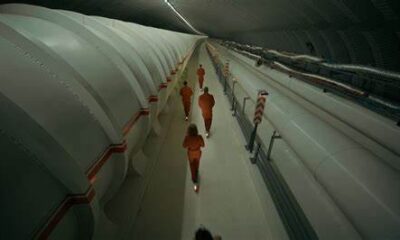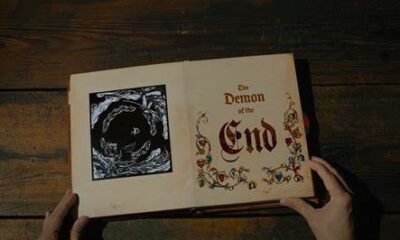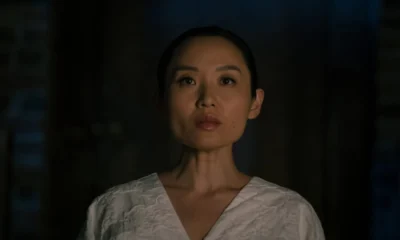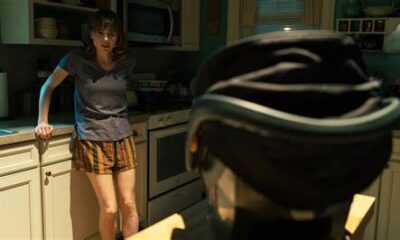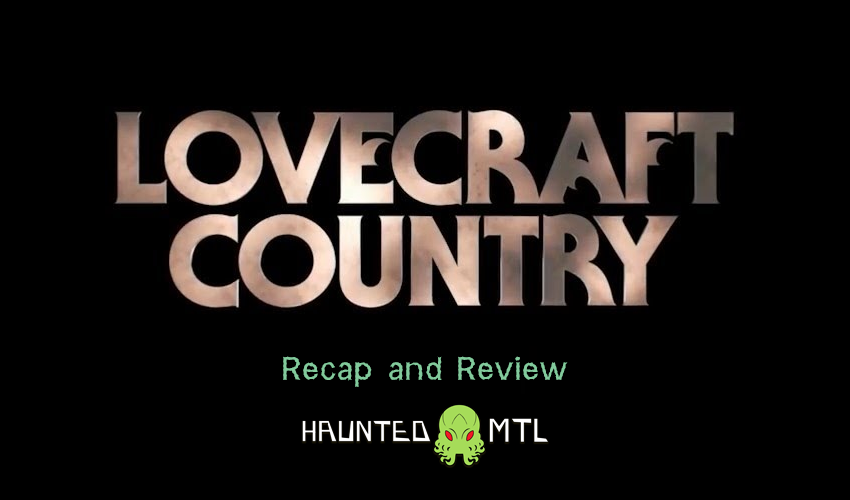
Lovecraft Country: S1E1
H. P. Lovecraft has had a bit of a resurgence lately. Not that the influence of his work has ever really been dormant in popular culture, but between recent explorations and debates on his work and his legacy of, let’s call it what it is, hate, the author has been again thrown into the spotlight. The latest chapter in this legacy comes from HBO in the form of Lovecraft Country.
HBO’s Lovecraft Country is adapted from the 2016 novel of the same name by Matt Ruff. The show is produced by Misha Green, J. J. Abrams, and Jordan Peele. The show airs Sunday nights on HBO and is available on HBO Max.
As for the show itself, let’s get weird with it, shall we? The reviews will be recaps will be filled with spoilers, but you can look at the review section without getting spoiled.
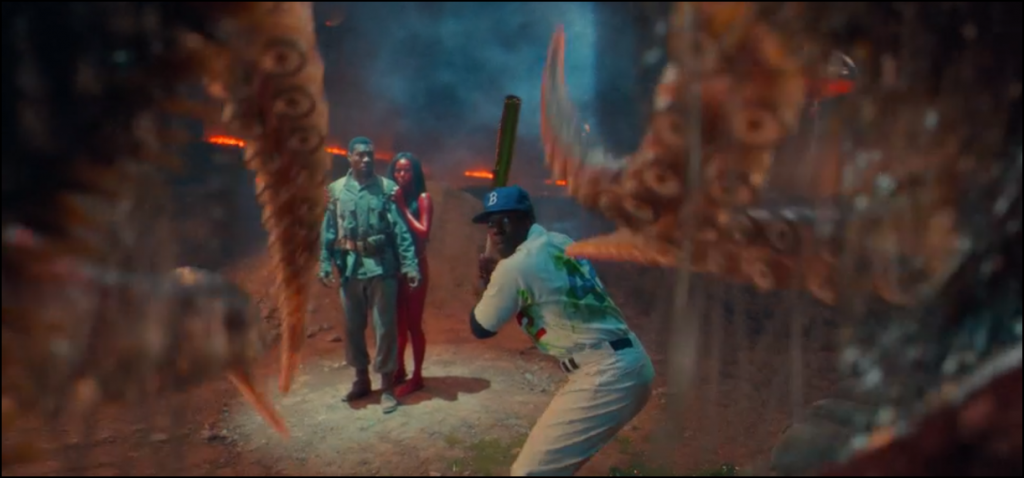
The story so far…
“Sundown” opens with a dream sequence filled with a number of pulp references as Atticus Freeman (Jonathan Majors, The Last Black Man in San Francisco) is riding the bus home. When the bus breaks down we see that we are in 1950s America, one of the last gasps of the Jim Crow era. Welcome to Lovecraft Country.
Atticus, returned from the Korean War is coming home to Chicago to find his father who has gone missing in “Lovecraft country.” Atticus recruits his uncle George (Courtney B. Vance, American Crime Story) and childhood friend Letitia (Jurnee Smollett, Birds of Prey) for a road trip to the town of Ardham; a name that is spun off from a familiar location in the works of H. P. Lovecraft, a figure who existed in the setting of the show and may not be writing fiction after all.
The road trip, under the guise of a research trip for a safe travel guide for black folks, published by George, immediately hits some snags. The show shows life across the midwest for the black community, juxtaposing their experiences with white Americana. The trio attempts to dine at an establishment, but make a shocking discovery and find themselves chased out of town by gun-toting racists. They are saved by a mysterious blonde-haired woman in a Rolls-Royce who stops the truck full of racists with what seems to be some power, flipping the truck and allowing Atticus and company to escape.
After some time learning what little there is to know about Ardham, Leti has a blow up with her brother who hosts the trio. They drive off the next morning, searching for the road to Arkham. Instead that find a racist sheriff and end up in the slowest, most tension-filled car chase to a county line ever.
Unfortunately, trapped by a roadblock of racist police, the trio are held at gunpoint in the woods and things go from bad to worse when mysterious multi-eyed creatures tear through four of the officers. The sheriff, de-armed by one of the beasts, transforms into one of the creatures inside a cabin where Atticus, George and an unfortunate deputy are hiding. The creatures, weak to light, are eventually fended off by Leti who brings the trio’s car to the cabin, flooding the space with light.
The next morning, Atticus and his band find the road into Ardham and arrive at a mansion. Atticus moves to knock on the door but it opens before he sets his hand on it. They meet a blond-haired man who seems to have been expecting their arrival.
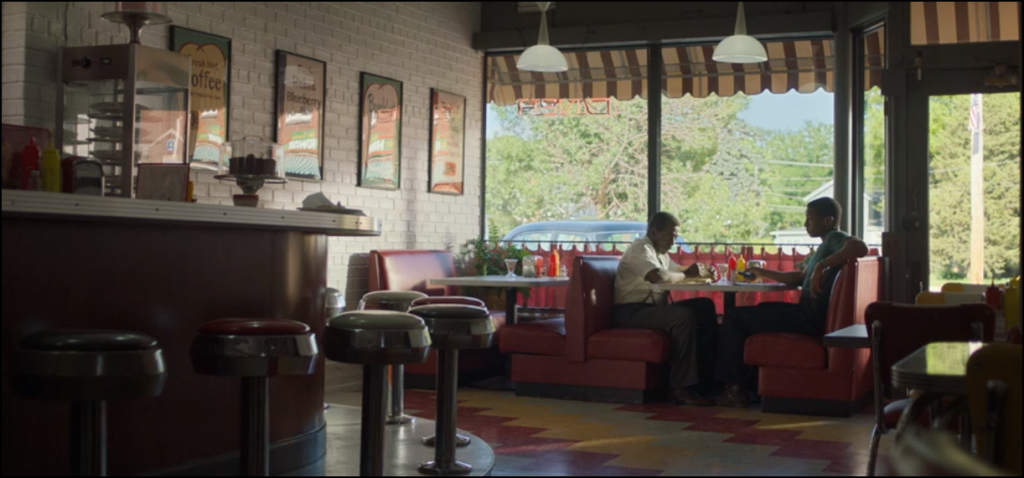
How it worked out…
The show is a stylish period piece that features some great performances, generally strong visuals, and some moments of genuine tension. It’s a fun ride through and through and enough of one that I want to experience the next episodes. As a pilot, “Sundown” largely does its job by setting up the core leads, a long term conflict, and just a hint at the weirdness to come. It also presents the kind of alien horror people expect when they think Lovecraft, but I am not sure if it does it all that well.
My biggest issue with the show is that it has two monsters and really only makes one scary, though it is hard not to make that monster scary. The show is at its absolute best when it deals with the looming threat of living while black in 1950s America. The pilot is absolutely at its best and most horrifying here. The moments of terror inflicted on black Americans is far more intense and affecting than a five-minute CGI-fueled attack of the Shoggoths. The presence of white paint and a loose tile chills far more effectively than a special-effects reel.
Despite my misgivings with the action-approach, it is still a lot of fun. Lovecraft would have hated it, for obvious reasons, but perhaps less obviously, it turns his ideas into the very sort of two-fisted pulp adventures he routinely criticized in his letters. But that’s fine, honestly. Is the idea of a wolf-like Shoggoth any sillier than the gelatinous mass of a thousand eyes as described in his own work? It’s a suitable introduction to the themes and aesthetics. A sort of big-budget sketch of the weirdness he pioneered. It gets people interested and diversifies the weird genre and hopefully continues to bring new voices into the fold when it comes to Lovecraftian themes.
But ultimately some fans and purists are going to be let down about the Abramsification of what should be an utterly hopeless and relentless experience. I would not say that I am let down, but I do want to one day see a high budget adaptation of the world of Shoggoths and Yith without the need for guns-a-blazin’.
But you know what? I’ll take the action-adventure spin on the themes and enjoy them just fine.
Lovecraft Country, “Sundown,” rates in at four Cthulhus.
 (4 / 5)
(4 / 5)

Miskatonic Musings
In each review, I have a section where I include some miscellaneous thoughts that don’t fit in the structure of the review but I feel are worth mentioning.
I just really liked the name, okay?
- The road trip monologue you heard comes from James Baldwin’s 1965 debate against William Buckley, Jr. This show will be heavily tied to the Jim Crow era. George’s guide book, for example, is clearly based on The Green Book. Also, look up Sundown towns if you are unfamiliar with the concept and prepare to feel sick to your stomach.
- A fair number of Lovecraft references in the premiere, as to be expected. The Outsider and Others makes an appearance. We also see what seems to be Cthulhu in Atticus’ dream. We of course have the Shoggoths. Vampires, another creature Lovecraft dabbled in, also get referenced, but George’s reference is specific to Dracula. Oh, and a refence to Herbert West as well.
- A lot of other great references as well to other pulp literature. Take, for example, the Martian princess in the dream sequence, who seems to be played by Jamie Chung. We also have tripods from War of the Worlds, and what seems to be a Roman Centurian in the battlefield. I’d be hesitant to include The Count of Monte Cristo as pulp work, but the presense of Alexandre Dumas is definitely a welcome literary element. Can’t forget Jackie Robinson, either.
- Who was Atticus speaking to on the phone all the way in Korea?
- I feel I should also explain my “qualifications” when it comes to my criticism of how the show tackles Lovecraft. I earned my M.A. writing about H. P. Lovecraft and writing an interactive fiction story that revolves around decolonizing Lovecraftian themes. I am currently in production of a mobile game version of that interactive fiction piece. You spend a couple years studying the guy (horribly racist warts and all) and his writing you end up sort of insufferable, like me.
- My review is already on the long-side, so things I want to address will be saved for later reviews. I’ll just throw out that Courtney B. Vance is a great actor and elevates the performances around him.
Please join us next week for another recap and review of HBO’s Lovecraft Country. Please let us know your thoughts on the show or this review in the comments.
Movies n TV
Wheel of Time A Question of Crimson Is a Political Espionage Delight
Episode two of Wheel of Time felt like the beginning of a long journey. Stories are unfolding, lives are changing, and blood is spilling.
Let’s discuss.
The story
We begin this episode in the past with Elayne’s mother, Queen Morgase. It turns out her rise to the throne was a bit, shall we say, cutthroat. So when she shows up at the White Tower, Siuan is concerned.
She might have reason to be, too.
Meanwhile, Rand, Egwene, Moiraine, Lan and Aviendha are in the Spine of The World. As they travel through some of the most breathtaking lands I have ever seen on a TV show, Egwene is plagued with nightmares. We think at first that’s just her trauma working itself through her system. But we soon find out that it might not be that straightforward.
Finally, Perrin returns home to heal after his hand is almost cut in half. But when he gets there he finds the town has been infested by Children of The Light. And they’re looking for him.
What worked
There was something heartwarming in this episode about political espionage and choking religious persecution. And that is Elayne’s relationship with her family.
I have consumed a lot of fantasy content with royal families. And I have never once heard a princess call her mother ‘Mum’. I’ve never seen royal siblings get along. And I have sure as hell never seen a princess have a good relationship with her step-parent.
This was refreshing. Even though Queen Morgase is kind of a horrible person she seems like a good mother. And that’s an unexpected delight.

Of course, this is just one storyline among many. And while this can sometimes be overwhelming, in this case it wasn’t.
I’ll be honest, some of these storylines are going to drag for me. I know this because I’ve read some of the Wheel of Time books and I have an idea that not all the characters exactly pique my interest.
No one likes all the characters. No one likes all the storylines. While I am here for the political espionage between Queen Morgase and Siuan, not everyone likes it. While others might be fascinated with Selene trying to win Rand back, I couldn’t care less.
Having multiple storylines keeps everyone’s attention better. So long as things don’t get out of hand. Things can easily get out of hand. But this seems to be managed well.
So far.
What didn’t work
As I mentioned above, I’m not thrilled with Rand’s story at this point. And while it’s fine to not like a storyline when there are this many to choose from, it’s not fantastic that the one I like the least is the one involving our two main characters. And anytime we were with the team at the Spine of The World, the only thing that brought me joy was Moirain’s hat. It reminded me of Stockard Channing’s hat in Practical Magic.
The problem is that Rand is Charlie Brown with controversial magical powers. He is boring, serious, and pessimistic.
And yes, I understand that he has a heavy emotional burden and he’s the Dragon Reborn and that’s quite taxing and all. But let’s be fair, there isn’t a single person in this show that doesn’t have a heavy burden. And most of them manage to be fun occasionally.

All that being said, this episode of Wheel of Time did exactly what it needed to do. It set up conflicts at each of the three locations. It established emotional ties between the characters and the events. And it established goals for everyone.
This was, in short, a solid episode. Not groundbreaking, not mind-blowing or life changing. It was simply good. It was entertaining and moved the plot forward.
Well done.
 (3.5 / 5)
(3.5 / 5)
Movies n TV
Wheel of Time Returns With A Bang
Wheel of Time is back for season three. There are mixed feelings regarding this. Last season, there were some serious pacing issues. And some serious sticking to the book’s storyline issues. But we’re two seasons in, and we don’t give up so easily. So let’s dive into episode one, To Race the Shadow.
By the way, I highly recommend watching this episode with the subtitles on. You’ll see why.
The story
We begin this episode with Liandrin facing a trial of sorts for her rampant betrayal. She does her best to gaslight her Aes Sedai sisters into thinking that Siuan Sanche is the real traitor.

When that doesn’t work, she reveals how many Black Aes Sedai have actually infiltrated the tower.
Spoiler, it’s a lot.
In the aftermath, our whole team gathers to drink and enjoy one night of relaxation before they head out to the Tear to form an army for Rand. All is going well until they’re attacked by myriad creatures and a sentient axe.
What worked
This episode was long. It had a run time of an hour and eleven minutes. And a lot of that run time was spent in heavy dialog scenes.
Fortunately, these were well-done scenes.
If you’re going to have a lot of talking scenes, there are good ways and bad ways to do it. Last season, we saw lots of examples of the bad way to do it. But this episode did it well. For one thing, other things were going on while conversations were taking place. The characters are drinking, playing games, walking through an interesting city. And the scenes themselves didn’t stretch out. They weren’t repetitive. We heard what the character had to say, then we moved on.
It was also nice that the point of these scenes wasn’t just info dumps. We had character development. We had romantic interactions. We had plot development and foreshadowing.
Overall, this episode felt like what it was. A moment of calm before a storm.
Taking a step back, I’d be remiss if I didn’t address the fight scene at the start of the episode. Because it was epic.
The magic looked amazing. The martial arts that went along with it looked fantastic. The costumes were beautiful. It was just incredibly fun to watch.
More than that, it was emotional. We lost some characters in that fight that were important. And it was clearly emotionally shattering for many of our characters, who found themselves betrayed by people they trusted.
So many of them.
It was a great way to open the season.
What didn’t work
Despite that, this episode wasn’t without its flaws.
First off, there were a lot of dialog scenes. And they were good scenes, as I’ve already discussed. But it was one after another after another. And when your episode is, again, an hour and eleven minutes, it’s maybe a little much to have so much chit-chat. Couldn’t some of these conversations, important as they were, have been moved to maybe another episode?
Finally, I want to talk about Egwene’s travel through the arches.

I feel like maybe there were some deleted scenes here. Because there must have been more to that visit than what we saw, right?
We could have seen Egwene battle Rand. That would have been badass and emotionally devastating. We could have seen her with a quiet life with Rand back home at the Two Rivers. We could have seen anything except for the quick clip of Rand in a bloody river, followed by Egwene being shoved back out in a bloody shift.
No products found.
Bad job. But at least it wasn’t an extended scene of Moiraine collecting bathwater, and then taking a bath while looking sad. If we’d started this season with another scene like that, it might have broken my brain.
Amazon dropped the first three episodes at once. So we’ll be back soon to talk about episode two. See you then.
 (4 / 5)
(4 / 5)
Movies n TV
Entertaining as hell: Eight Legged Freaks (2002) Review
Early 2000s is a special era for the industry. It accepts the cheesiness and corniness of movie making, in turn producing some gems in their own right. Eight Legged Freaks starring David Arquette and young Scarlet Johanson is a horror comedy about giant spiders who overtake a small town. As crazy as that premise sounds, the movie surprisingly has a ton of heart and is super entertaining. Let’s review, shall we?
Plot
We start Eight Legged Freaks with a shot of toxic waste spilling into the water supply of Joshua, a spider farm owner. He is friends with Mike, one of our protagonists, who is a science geek and a spider enthusiast. Mike notices something quite right upon visiting Joshua, but no one takes him seriously. We are then introduced to the rest of the crew. Mike’s mother Samantha, the town sheriff, is too busy chasing Ashley, his sister, who is dating the town mayor’s son Bret (something Samantha does not approve of). We also have Chris, who returns to the town to save his father’s legacy in the town mines. He has opposition from Wade, Bret’s father, who wants to use the mines for his business ventures. Lots of drama going on that will only get juicier once the spiders get loose.
The creepy crawlies quickly dispose of Joshua and make their grand appearance after Ashley rejects Bret’s advances, abandoning him in the middle of a desert. A glorious chase sequence ensues as the spiders make their way towards the town, wreaking havoc on its residents. In a true horror fashion (which the movie acknowledges), it takes some convincing from Mike and then from Samantha for the town to take the threat seriously. The tongue-in-cheek style of narrative adds the comedy aspect to a movie that would otherwise burn out fairly quickly.
The remaining characters hide out in a shopping mall as it’s the only somewhat sturdy building in the area. This doesn’t last long as the spiders break in, forcing them to run through the mines. Their resources to fight the creepy crawlies off are limited as the methane gas doesn’t allow them to use firearms. Such conditions require resourceful thinking from Chris, who uses perfume to fend off the leader of the spider group and save himself during the climax of the movie.
Character dynamics are not forgotten once the action kicks in. We have Chris confessing his long-term feelings for Samantha which she knew all along, which provided some comedic relief. Bret also reunites with Ashley and apologises for being an asshole. Mike finally gets the appreciation he deserves as his knowledge saves the townsfolk more than once during the whole ordeal.
We end the movie with the town’s radio show person telling the story as an urban legend during his segment. This brings it into question – how much of it happened the way he said it did? We can only guess…
Overall thoughts
Eight Legged Freaks is a fun creature feature with some self-aware commentary on genre tropes that doesn’t take itself too seriously. The acting is good, the pacing fitting and the characters are likeable enough for you to want them to make it through. Definitely a must watch, if you don’t suffer from arachnophobia, that is.
 (5 / 5)
(5 / 5)
- What do you get when you cross toxic waste with a bunch of exotic spiders? Eaten! The townies of Prosperity, Arizona will all become a screaming smorgasbord if mutated arachnids as big as SUVs have their way in this comedy/horror crowd pleaser whose creators include the producers of Independence Day and Godzilla
- Spiders that leap like gazelles, web-spitting spiders, spiders that suck your insides out as if through a straw—they’re all among the behemoths conjured up by an inventive effects team
- David Arquette (Scream) leads the two-legged stars, mobilizing the citizenry in a last-ditch fight to survive
Last update on 2025-03-10 / Affiliate links / Images from Amazon Product Advertising API


